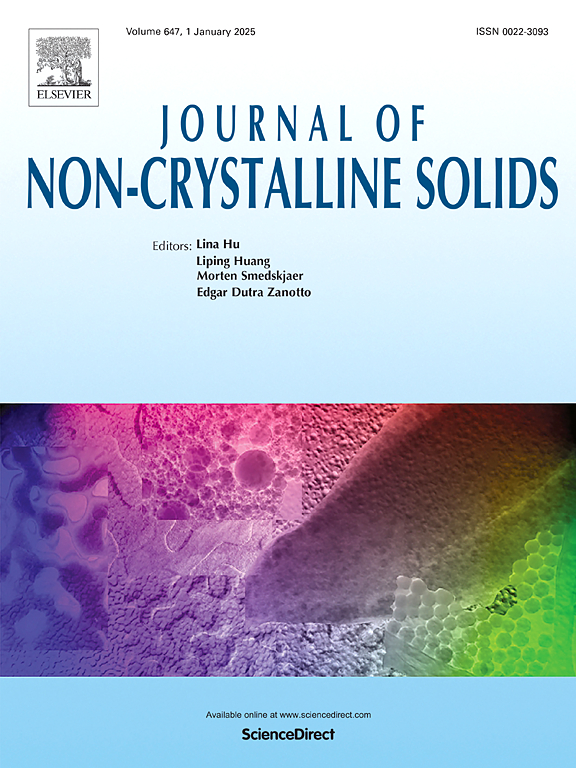Phase evolution and silicate network dynamics of coal-derived inorganic slags during high-temperature melting: A multiscale experimental and molecular dynamics investigation
IF 3.5
3区 材料科学
Q1 MATERIALS SCIENCE, CERAMICS
引用次数: 0
Abstract
This study investigates the phase evolution and silicate network dynamics of coal-derived inorganic slags under high-temperature melting (1300–1400 °C), combining multiscale experimental characterization with molecular dynamics (MD) simulations. Two representative materials—Shenmu coal (SM) and Beishan coal (BS)—were analyzed to elucidate crystallization-amorphous transformation pathways and their environmental implications. Quantitative analyses revealed: X-ray diffraction (XRD), nuclear magnetic resonance (NMR), and X-ray photoelectron spectroscopy (XPS) confirmed calcium aluminosilicate-dominated microstructures, with >87 % vitreous phase content and 55–62 % heavy metal immobilization efficiency. Molecular dynamics simulations quantified cation diffusion coefficients (Ca²⁺: ∼1.7 × 10⁻⁹ m²/s > Fe2⁺: ∼9.0 × 10⁻¹⁰ m²/s > O²⁻: ∼7.5 × 10⁻¹⁰ m²/s > Al³⁺: ∼5.0 × 10⁻¹⁰ m²/s > Si⁴⁺: ∼3.0 × 10⁻¹⁰ m²/s), demonstrating the critical role of [SiO₄]⁴⁻ tetrahedral polymerization in governing slag fluidity. The developed SiO₂-Al₂O₃-CaO-FeO quaternary MD model bridged molecular-scale dynamics (Qⁿ distribution, >90 % bridged oxygen content) with macroscopic properties The results revealed that SM has a high degree of polymerization (R = 20.19) and requires further pretreatment to be used as a raw material for the preparation of geopolymers. Compared with BS molten slag, it is more suitable as a raw material for resource utilization due to its low degree of polymerization (R = 7.46) and high vitreous phase content of 100 %.
高温熔融过程中煤系无机炉渣的相演化和硅酸盐网络动力学:多尺度实验和分子动力学研究
本研究将多尺度实验表征与分子动力学(MD)模拟相结合,研究了高温熔融(1300-1400℃)下煤系无机炉渣的相演化和硅酸盐网络动力学。对两种具有代表性的煤——神木煤(SM)和北山煤(BS)进行了分析,以阐明结晶-非晶态转变途径及其环境意义。定量分析表明:x射线衍射(XRD)、核磁共振(NMR)和x射线光电子能谱(XPS)证实了钙铝硅酸盐为主的微观结构,玻璃相含量为87%,重金属固定效率为55 - 62%。分子动力学模拟量化了阳离子扩散系数(Ca 2 +:∼1.7 × 10⁻¹⁰m²/s > Fe2 +:∼9.0 × 10⁻¹⁰m²/s > O 2 +:∼7.5 × 10⁻¹⁰m²/s > Si³+:∼3.0 × 10⁻⁰m²/s),证明了[SiO₄⁰m²]4⁻四面体聚合在控制矿渣流动性中的关键作用。建立的SiO₂-Al₂O₃-CaO-FeO四元MD模型桥接分子尺度动力学(Q₂分布,桥接氧含量>; 90%)具有宏观性能。结果表明,SM具有较高的聚合度(R = 20.19),需要进一步预处理才能作为制备地聚合物的原料。与BS熔渣相比,其聚合度低(R = 7.46),玻璃相含量高达100%,更适合作为资源利用的原料。
本文章由计算机程序翻译,如有差异,请以英文原文为准。
求助全文
约1分钟内获得全文
求助全文
来源期刊

Journal of Non-crystalline Solids
工程技术-材料科学:硅酸盐
CiteScore
6.50
自引率
11.40%
发文量
576
审稿时长
35 days
期刊介绍:
The Journal of Non-Crystalline Solids publishes review articles, research papers, and Letters to the Editor on amorphous and glassy materials, including inorganic, organic, polymeric, hybrid and metallic systems. Papers on partially glassy materials, such as glass-ceramics and glass-matrix composites, and papers involving the liquid state are also included in so far as the properties of the liquid are relevant for the formation of the solid.
In all cases the papers must demonstrate both novelty and importance to the field, by way of significant advances in understanding or application of non-crystalline solids; in the case of Letters, a compelling case must also be made for expedited handling.
 求助内容:
求助内容: 应助结果提醒方式:
应助结果提醒方式:


